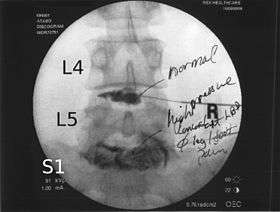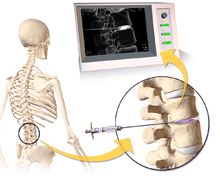Lumbar provocative discography
| Lumbar provocative discography | |
|---|---|
| Intervention | |
 Lumbar provocative discography showing a degenerated disc, L5-S1 with normal disc L4-L5 | |
| Other codes |
CPT 62290 (lumbar/sacral) CPT 62291 (Cervical/Thoracic) CPT 72295 radiological supervision (lumbar/sacral) CPT 72285 radiological supervision (cervical/thoracic) |

Lumbar provocative discography (also referred to as "discography" or discogram) is an invasive diagnostic procedure for evaluation for intervertebral disc pathology. It is usually reserved for persons with persistent, severe low back pain (LBP) who have abnormal spaces between vertebrae on magnetic resonance imaging (MRI), where other diagnostic tests have failed to reveal clear confirmation of a suspected disc as the source of pain, and surgical intervention is being considered.
Needles are inserted through the back into the disc near the suspect area, guided by fluoroscopic imaging. Fluid is then injected to pressurize the disc, and any pain responses are recorded.
This is repeated in random order for the various discs, without the patient knowing which disc is pressurized. This can be used to detect patients who may be exaggerating their symptoms, or to assess their pain response and hence their suitability for recovery from possible surgery (often a Discectomy).
A contrast agent is introduced, and after the procedure a CT scan identifies leakage from the discs to identify any spinal disc herniation.
Possible complications include nerve damage, discitis, an infection of the disc. Strong antibiotics are usually administered as a precaution.
Its use in predicting surgical outcomes is controversial.
References
- "Clinical Policy Bulletin: Discography", Aetna.com
- medscape.com
- Maximize Your Reimbursement for Discography